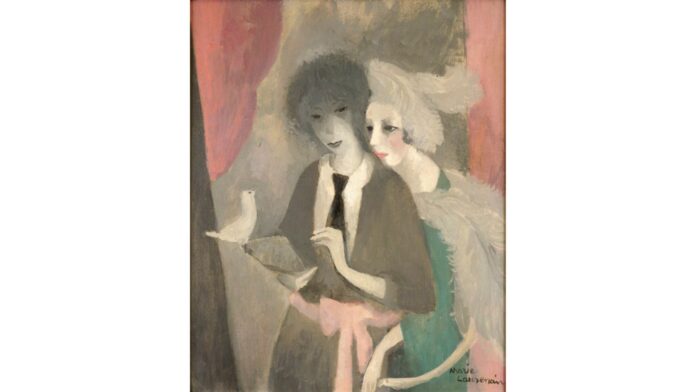Marie Laurencin was a prominent figure in the bustling Parisian art scene of the early 20th century. She was born in Paris and spent most of her life there getting involved with Picasso’s artistic circle in 1907. She was notable for being one of the few successful women artists during a time when the field was composed primarily of men.
Laurencin had a successful career, popular not only for the ethereal feminine quality in her work, but also for the subtle queer sensibility it contained. She was considered a major artist until her death in 1956, when her reputation began to decline.
However, in recent years there has been a resurgence of interest in Laurencin. The Barnes Foundation is doing its part in that resurgence by mounting the first major U.S. exhibition of her work in 30 years. The exhibit covers her entire career, from her early student works, to the theatrical design work she pursued in her later years. The exhibit, “Marie Laurencin: Sapphic Paris” will be on display at the Barnes through Jan. 21.
In the course of her life, Laurencin had relationships with both men and women, marrying twice, though never having children. Given this, sticklers may quibble over defining her as lesbian or queer, but it’s clear that her longest and most significant relationships were with women. In 1925, Laurencin met Suzanne Moreau, who was hired as a maid, but became her lover and, eventually, her heiress.
Throughout her career, the subjects of her paintings were almost exclusively women. She went through several stylistic phases as well. As a student, her work was mostly romantic realism. During her time with Picasso and company, she experimented successfully with cubism. However, it was during her self-imposed exile from Paris during WWI that she came fully into her own.
In 1914, Laurencin married a German aristocrat, and they lived briefly in Germany. However, when WWI broke out, because her husband didn’t want to serve in the German military, they relocated to Spain where Laurencin eventually becomes part of an expatriate circle of artists that vastly expanded her artistic sensibilities, helping her find her true artistic voice. It was also then that she met and became friends with Gertrude Stein and Alice B. Toklas.
After the war, Laurencin and her husband returned to Düsseldorf. However, she soon divorced him and returned to Paris, where she embarked on the height of her career. In 1923, she began collaborating with major theater artists, such as ballet impresario Serge Diaghilev, designing sets and costumes.
Subsequent years were very productive. In addition to painting and theatrical design, Laurencin produced engravings, illustrated books, dabbled in interior design, and taught at the L’Atelier XVI, an art academy in Paris, as well as painting portraits of such luminaries as Coco Chanel and Helena Rubinstein.
Contemporary critics write that Laurencin is known as an originator of the sensibility called “Sapphic modernity.” While the subtle queerness of her paintings escaped (or was not mentioned by) viewers of her time, the queerness is much more obvious to modern viewers.
In addition to the main exhibition, the Barnes has scheduled several related educational programs that add depth and context to Laurencin’s work. The most notable program would be an online course taught by Jonathan D. Katz called “Art and the First ‘Homosexuals.’” This course — which includes four classes scheduled Nov. 8-Dec. 6 — surveys artistic representations of the emerging “homosexual” identity from the early 1900s through the first decades of the 20th century.
Marie Laurencin: Sapphic Paris runs through Jan. 21 at the Barnes Foundation, 2025 Ben Franklin Parkway. For information about museum hours, tickets, or ancillary programs, visit barnesfoundation.org.
